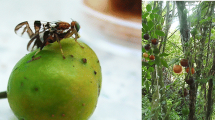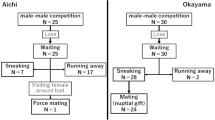Abstract
We studied the activity and spatial distribution of the robber fly,Promachus albifacies, in a desert grassland habitat in central New Mexico. Late in the season males spent most of the daytime on or near cholla and yucca plants that had dead stems or dead flower stalks at least 1 m high. Of the three hypotheses (thermoregulation, foraging, mate encounter site) considered as explanations for this distribution, the mate-encounter-site hypothesis was best supported. Plants used by females as oviposition sites were the focus of male activity. Males perched within or near these plants and attempted copulations with females detected nearby. Most matings were initiated at these locations. Seasonal changes in male and female activity also supported the mate-encounter-site hypothesis. Early in the season, females spent little time ovipositing, and predictably, males spent little time on or near these plants. Such a mating system may be described as resource defense polygyny, since males acted aggressively toward one another at oviposition sites even when females were not present. However, the short tenure of males at these sites is suggestive of scramble competition polygyny. We discuss possible reasons why this particular mating system has evolved.
Similar content being viewed by others
References
Alcock, J. (1979). The evolution of intraspecific diversity of male reproductive strategies in some bees and wasps. In Blum, M. S., and Blum, N. A. (eds.),Sexual Selection and Reproductive Competition in Insects, Academic Press, New York.
Alcock, J. (1989). The mating system ofBrechmorhoga pertinax (Hagen): The evolution of brief patrolling bouts in a “territorial” dragonfly (Odonata: Libellulidae).J. Insect Behav. 2 49–62.
Bradbury, J. W. (1985). Contrasts between insects and vertebrates in the evolution of male display, female choice, and lek mating. In Holldobler, B., and Lindauer, M. (eds.),Experimental Behavioral Ecology and Sociobiology, Fisher, New York.
Dickinson, J. L. (1992). Scramble competition polygyny in the milkweed leaf beetle: Combat, mobility, and the importance of being there.Behav. Ecol. 3 32–40.
Emlen, S. T., and Oring, L. W. (1977). Ecology, sexual selection, and the evolution of mating systems.Science 197 215–223.
Hastings, J. M. (1989). The influence of size, age, and residency status on territory defense in male western cicada killer wasps (Sphecius grandis, Hymenoptera: Sphecidae).J. Kans. Entomol. Soc. 62(3): 363–373.
Lavigne, R. J. (1971).Backomyia seminoensis sp. n. from Wyoming with ethological notes onB. limpidipennis.J. Kans. Entomol. Soc. 44(3): 337–342.
Lavigne, R. J., and Holland, F. R. (1969). Comparative behavior of Wyoming robber flies (Diptera: Asilidae). University of Wyoming agricultural Experimental Station Science Monograph 18, Laramie.
Morgan, K. R., and Shelly, T. E. (1988). Body temperature regulation in desert robber flies.Ecol. Entomol. 14 419–428.
O'Neill, K. M. (1983). The significance of body size in territorial interactions of male beewolves (Hymenoptera: Sphecidae,Philanthus).Anim. Behav. 31 404–411.
O'Neill, K. M. (1992). Body size asymmetries in predatory interactions among robber flies.Ann. Entomol. Soc. Am. 85 34–38.
O'Neill, K. M., Kemp, W. P., and Johnson, K. A. (1990). Behavioral thermoregulation in three species of robber flies (Diptera, Asilidae:Efferia).Anim. Behav. 39 181–191.
Schwagmeyer, P. L., and Woontner, S. J. (1986). Scramble competition polygyny in thirteen-lined ground squirrels: The relative contributions of overt conflict and competitive mate searching.Behav. Ecol. Sociobiol. 19 359–364.
Thornhill, R., and Alcock, J. (1983).The Evolution of Insect Mating Systems, Harvard University, Cambridge, MA.
Author information
Authors and Affiliations
Rights and permissions
About this article
Cite this article
Hastings, J.M., Dodson, G.N. & Heckman, J.L. Male perch selection and the mating system of the robber fly,Promachus albifacies (Diptera: Asilidae). J Insect Behav 7, 829–841 (1994). https://doi.org/10.1007/BF01997129
Received:
Accepted:
Issue Date:
DOI: https://doi.org/10.1007/BF01997129




